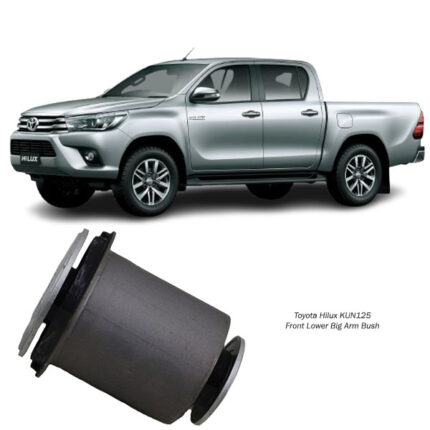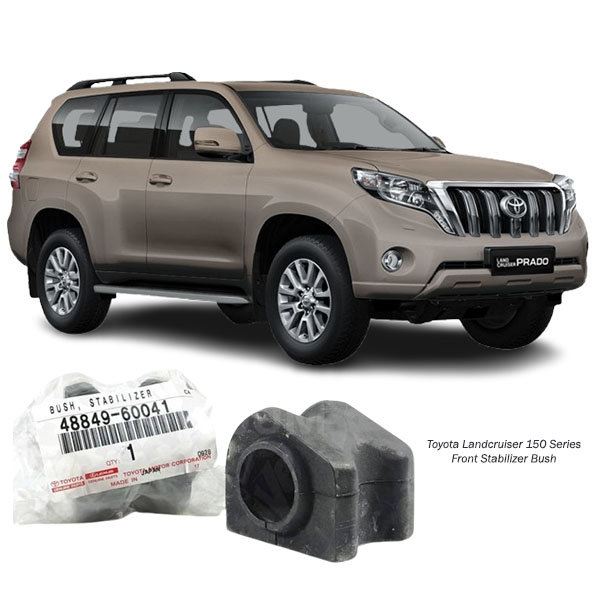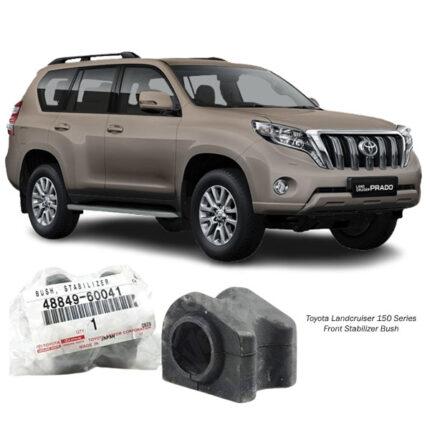Get Toyota Landcruiser 150 Series Front Stabilizer Bush 48849-60041 in Kenya
The Front Stabilizer Bush (also called a sway bar bushing) is a small but vital component in your vehicle’s suspension system. It plays a crucial role in:
Reducing body roll when turning
Enhancing steering stability
Preventing excessive vibrations
Ensuring a smooth and controlled ride
Like all rubber components, stabilizer bushes wear out over time, leading to clunking noises, reduced handling performance, and uneven tire wear. In this guide, we’ll explore:
What is a Front Stabilizer Bush?
Functions & Importance
Symptoms of Worn Bushings
Types of Stabilizer Bushings
How to Replace a Front Stabilizer Bush
Maintenance & Longevity Tips
OEM vs. Aftermarket Bushings
What is a Front Stabilizer Bush?
The Front Stabilizer Bush is a rubber or polyurethane part that secures the stabilizer bar (sway bar) to the vehicle’s frame. It prevents excess movement and absorbs vibrations, ensuring proper suspension function.
Key Components:
Stabilizer Bar (Sway Bar) – A metal bar that connects the left and right sides of the suspension.
Stabilizer Bushings – Hold the stabilizer bar in place, preventing metal-to-metal contact.
Mounting Brackets – Secure the stabilizer bushings to the chassis.
When the stabilizer bushings are in good condition, they keep the stabilizer bar firmly in place, allowing for smooth, controlled handling.
Functions & Importance of the Front Stabilizer Bush
The Front Stabilizer Bush is crucial for suspension performance and overall vehicle handling.
Reduces Body Roll
-
Stabilizer bushings keep the sway bar in place, preventing excessive leaning when cornering.
-
This ensures better stability and road grip.
Enhances Steering Control
-
Worn-out bushings cause the sway bar to move excessively, leading to loose or unpredictable steering.
-
New bushings improve steering response and accuracy.
Improves Ride Comfort
-
The bushings absorb road vibrations, preventing harsh impacts from reaching the driver and passengers.
Reduces Suspension Noise
-
Bad bushings create clunking, squeaking, or knocking sounds, especially when driving over bumps.
Prevents Excess Tire Wear
-
Helps maintain proper wheel alignment, reducing uneven tire wear.
Ignoring worn stabilizer bushings can lead to reduced handling performance, poor steering response, and potential suspension damage.
Symptoms of a Worn-Out Front Stabilizer Bush
Since stabilizer bushings degrade due to heat, moisture, road debris, and stress, it’s essential to recognize the warning signs early.
Clunking or Knocking Sounds – Loose bushings allow the sway bar to move, creating knocking noises when driving over bumps.
Increased Body Roll – If the vehicle leans excessively when turning, it’s likely due to damaged stabilizer bushings.
Loose or Unstable Steering – If steering feels sloppy or less responsive, worn stabilizer bushings could be the cause.
Squeaking Noises – Cracked or dry bushings produce high-pitched squeaks, especially in cold weather.
Uneven Tire Wear – Misalignment from bad bushings leads to irregular tire wear patterns.
If any of these symptoms occur, replacing the front stabilizer bush can restore your vehicle’s handling and ride comfort.
Types of Stabilizer Bushings
There are two main types of stabilizer bushings:
Rubber Bushings –
Softer, providing a comfortable ride.
Excellent at absorbing vibrations.
Wears out faster (lasts 3-5 years).
Polyurethane (Poly) Bushings –
More durable and resistant to heat, oil, and moisture.
Improves handling and steering precision.
Stiffer ride, may increase vibrations.
For daily driving, rubber bushings are ideal. For performance or off-road use, polyurethane bushings provide better durability and control.
How to Replace a Front Stabilizer Bush
Tools Required:
Jack & Jack Stands
Wrench Set
Socket Set
Pry Bar
Silicone Grease (for polyurethane bushings)
Installation Steps:
Lift the Vehicle & Secure It
-
Park on a flat surface and engage the parking brake.
-
Use a jack to lift the front of the vehicle and secure it with jack stands.
Locate the Stabilizer Bushings
-
Find the sway bar, mounted to the frame with bushings and brackets.
Remove the Mounting Brackets
-
Use a socket wrench to loosen the bolts securing the brackets.
-
Carefully remove the brackets and slide out the old bushings.
Install the New Bushings
-
If using polyurethane bushings, apply silicone grease inside the bushing to prevent squeaking.
-
Position the new bushings around the stabilizer bar.
Reinstall the Brackets & Tighten the Bolts
-
Secure the bushings with the mounting brackets.
-
Torque the bolts to the manufacturer’s recommended specification.
Lower the Vehicle & Test Drive
-
Reinstall the wheels and lower the vehicle.
-
Take the car for a test drive, checking for noise and stability.
Maintenance & Longevity Tips
To extend the lifespan of your stabilizer bushings, follow these tips:
Regular Inspections – Check the bushings every 12,000-15,000 miles for cracks or wear.
Lubricate Polyurethane Bushings – Apply silicone grease during installation to prevent noise.
Avoid Rough Roads – Potholes and bumps accelerate bushing wear.
Replace in Pairs – Always replace both left and right bushings together for balanced handling.
OEM vs. Aftermarket Bushings – Which One to Choose?
| Feature | OEM | Aftermarket |
|---|---|---|
| Fit & Compatibility | Perfect Fit | May Require Adjustments |
| Ride Comfort | Softer & Quieter | May be Stiffer |
| Durability | Designed for Longevity | Varies by Brand |
| Warranty | Manufacturer-Backed | Limited or None |
| Cost | More Expensive | More Affordable |
For best performance and longevity, OEM rubber bushings are ideal. If you want stiffer handling, consider high-quality polyurethane bushings.
Follow us on Facebook for more parts.





Reviews
Clear filtersThere are no reviews yet.